火星 月惑星研究会 関西支部

Mars Image 2005/09/18(UT)
米山誠一,鈴木 隆,瀧本郁夫,三品利郎,新井 優,畑中明利,冨田安明,池村俊彦,柚木健吉,松本博久,
Ralf Vandebergh,Geert Vandenbulcke,Ricardo Nunes,Jan Adelaar,John Kirchhoff,Damian Peach,Richard Bosman,Christophe Pellier,David M Moore
S.Yoneyama,T.Suzuki,I.Takimoto,T.Mishina,M.Arai,A.Hatanaka,Y.Tomita,T.Ikemura,K.Yunoki,H.Matsumoto,R.Vandebergh,G.Vandenbulcke,Ricardo,J.Adelaar,J.Kirchhoff,D.Peach,R.Bosman,Christophe.P,D.Moore
解説(安達)
西と東のリムには霧が見える。明るく目立った霧ではない。池村氏はアルシ
ア・シルバ(Arsia Silva;125W,-5)に正午前から雲が沸き上がってくる様子を
鮮明にとらえた。柚木氏の青画像ではあちこちに白雲の塊のある様子が記録さ
れています。また、池村氏と同じ様子を青画像で鮮明に記録されたのはすばら
しいことです。前日に見つかったアキダリウム(MareAcidarium;30W,+50)に小
さく、白く、明るい点は成長しなかったようだ。(reported by 19 observers)
The fog is seen in limb in the west and the east. It is not a fog that
stands out brightly. Ikemura clearly caught the appearance where the
cloud boils up during noon in Arsia Silva (125W,-5). The appearance
with the mass of white clouds is recorded here and there in a blue
image of Yunoki. It is that Yunoki is wonderful moreover that the same
appearance as Ikemura was clearly recorded in a blue image. A small
white, bright point of Mare Acidarium (30W,+50) found the day before
seems not to have grown up. (reported by 19 observers)
FROM Makoto ADACHI
-------------------------------------------------------------------------------------
|
Seiichi Yoneyama(200mm F4 Newton,ToUcam PRO)
|
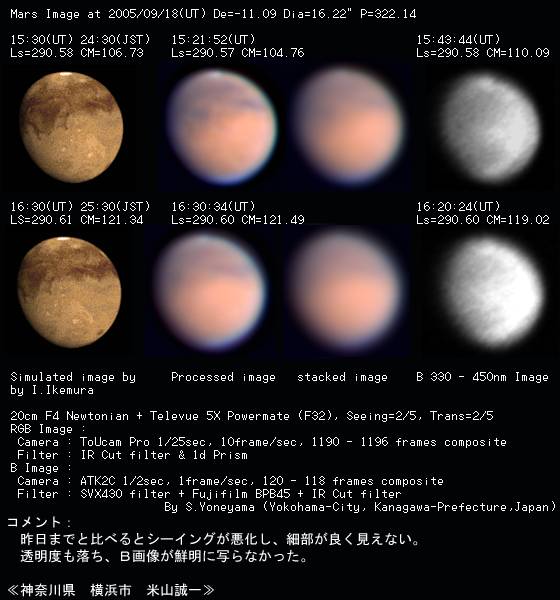
≪神奈川県横浜市 米山誠一≫
|
Takashi Suzuki (180mmMakustov Casegrain, ToUcam Pro)
|
コメント:シーイングが良かったので欠け際の雲など細部が写りました。
眼視では南極冠ははっきりしません。
 [Takashi Suzuki (Hachiouji-City Tokyo Japan)]
≪東京都八王子市 鈴木 隆≫
[Takashi Suzuki (Hachiouji-City Tokyo Japan)]
≪東京都八王子市 鈴木 隆≫
|
Ikuo Takimoto (310mm Newtonian :ToUcam Pro )
|
コメント:シーイングが良くない。昼間は32℃の
気温が、この時間では23℃になっている。
北極雲が青白い。
今週は、天気が良くない予報が出ている。
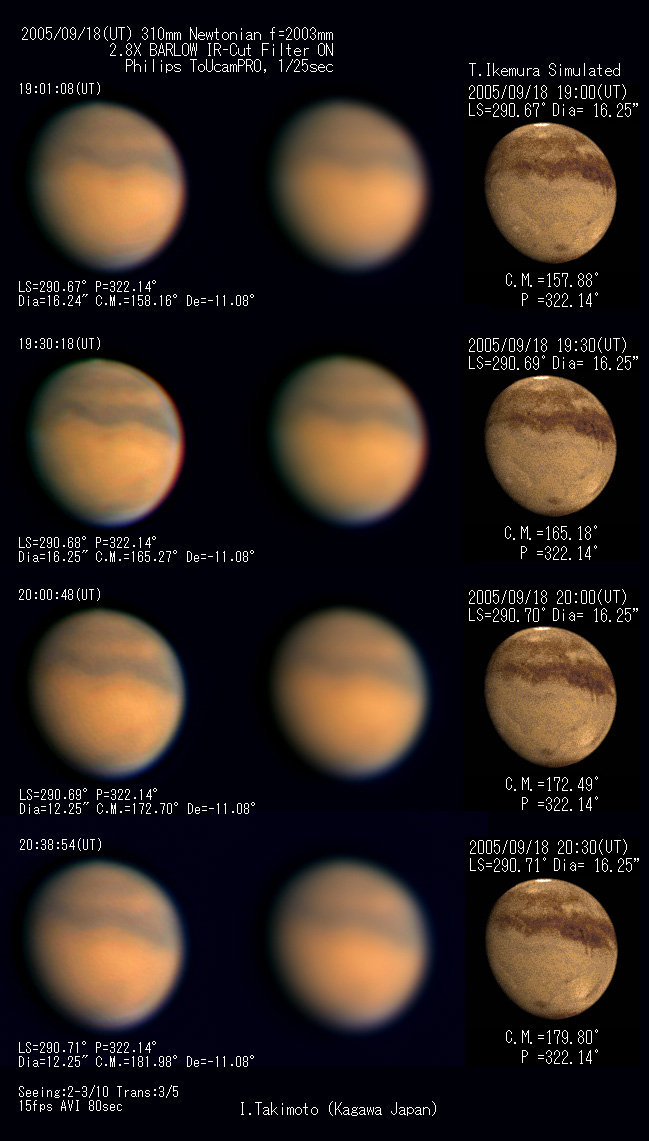 [Ayauta-gun Kagawa-Prefecture Japan]
≪香川県 綾歌郡 瀧本郁夫≫
[Ayauta-gun Kagawa-Prefecture Japan]
≪香川県 綾歌郡 瀧本郁夫≫
|
Toshirou.Mishina (200mm Newtonian, ToUcam Pro)
|
空に薄雲(巻雲)がかかっていた。
NPCフィルタを使うと北極の雲が水色に見えた。
IR-CutとNPCフィルタを交互に交換するたびに、
ホワイト・バランスを調整し直した。それゆえ、撮影のたびに火星の色
が変わってしまった。
Thin clouds(cirrus) had hung in the sky this night(Sept.18th,2005 UT).
When the NPC filter is used, the cloud of the
North Pole is seen the light blue color.
Whenever the IR-Cut filter was alternately exchanged for the NPC filter
it tried to adjust the white balance.
Therefore, the color of Mars has changed at the time of each taking a picture.
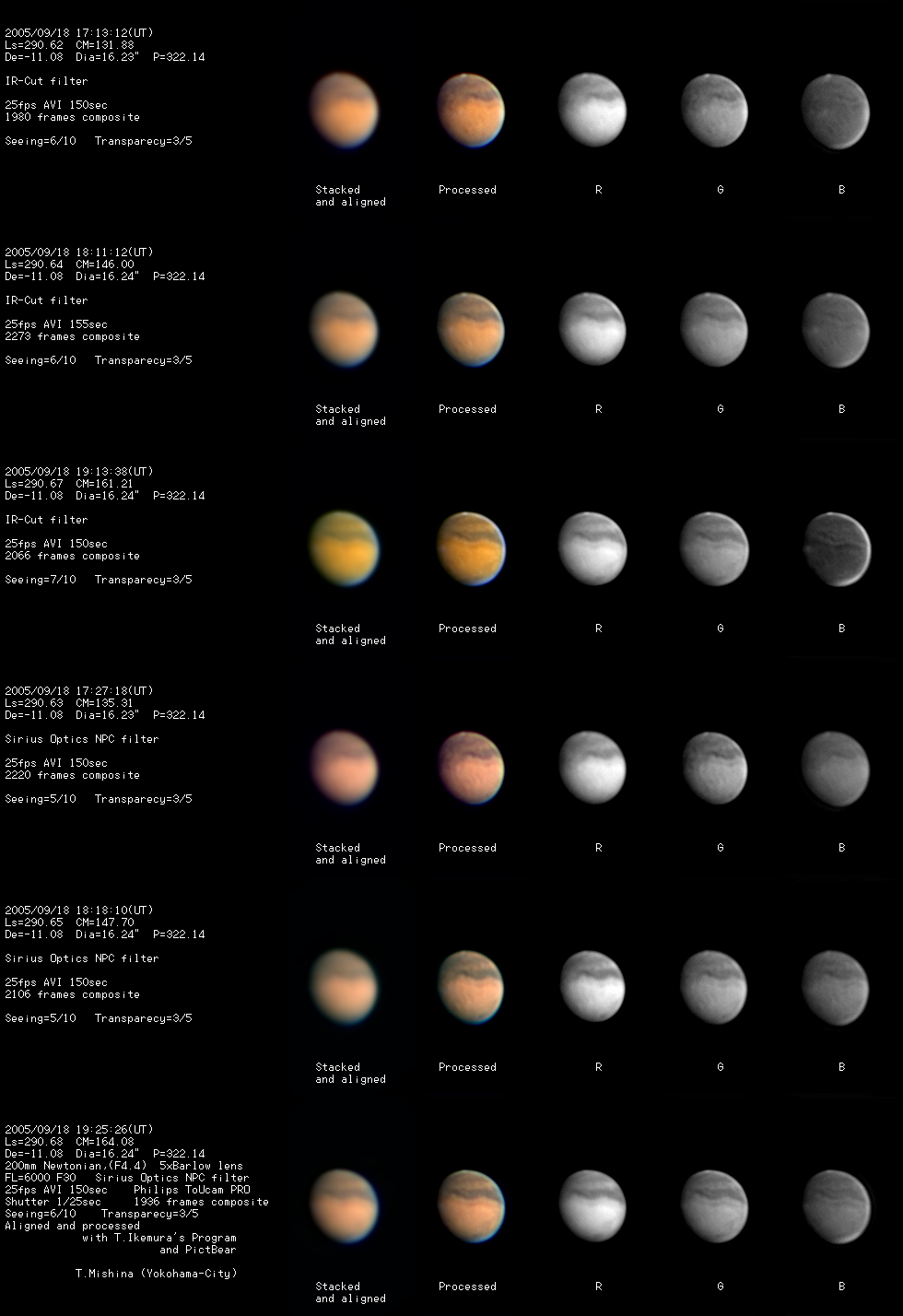 ≪神奈川県 横浜市 三品利郎≫
≪神奈川県 横浜市 三品利郎≫
|
Masaru Arai (280mmSMC Newton, Philips ToUcam Pro PCVC740K)
|
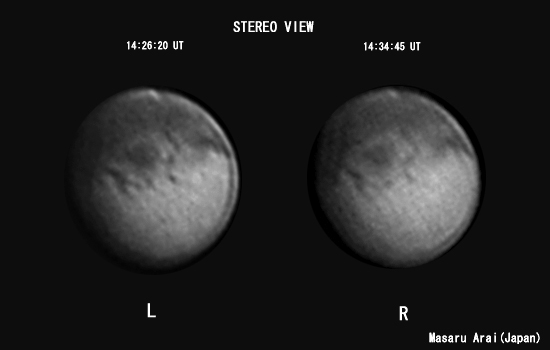
280mm SCT,2×Extender(150%リサイズ) Philips ToUcam Pro, 1/33 sec
1200frames composite Seeing:3/10 Transp.:2/5
−−−−−−−−−−−−−−
280mm SCT,2×Extender(150%リサイズ) Philips ToUcam Pro, 1/33 sec
1200frames composite Seeing:3/10 Transp.:2/5
−−−−−−−−−−−−−−
さざ波の様なSeeingのせいでしょうかStack処理の結果が良くありません
でした。ステレオ画像中、ソリスから北極に伸びる数本の血管のような模様に興味が
あります。
−−−−−−−−−−−−−−
ステレオ画像を用意しました。極端なEnhanced処理を行っているので実態とはかけ離
れていますが、表面の凹凸の具合を判断できるのではと考えています。火星の自転を
利用したステレオなので効果があるのは中央部のみになります。今回は、LR画像が
不揃いで見にくくなっています。
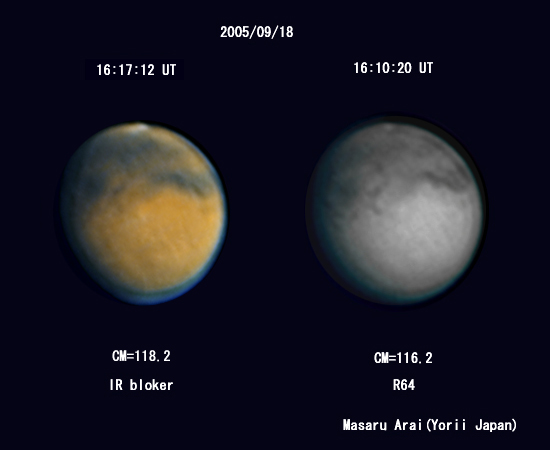 [Masaru Arai Yorii-machi Saitama-Prefecture Japan]
≪埼玉県寄居町 新井 優≫
[Masaru Arai Yorii-machi Saitama-Prefecture Japan]
≪埼玉県寄居町 新井 優≫
|
Akitoshi Hatanaka (400mm Cassegrain, ToUcam Pro)
|
40cm Cassegrain(F15) 1 degree Prisum IR block Filter
Philips ToUcam Pro Rezistax seeing 4/10 trans 7/10
像のゆれは少ないが、模様のコントラストがなく、よく見えない。
2:30くらいから、コントラストも回復してきたようだったが、3:00を
少しすぎた頃から、像がよくゆれるようになった。
タルシスの一番南のアルシア山と、エリシウムに雲がかかっているで、
B画像に白く写っている。
ソリスも西から見えだした。
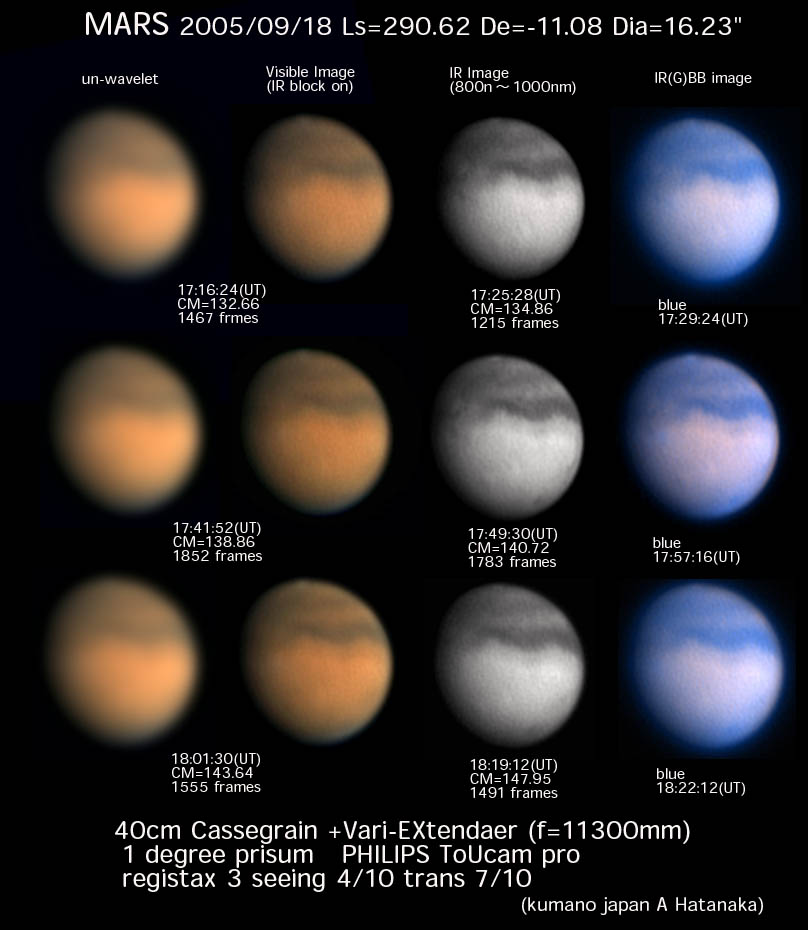 ≪三重県熊野市 畑中明利≫
≪三重県熊野市 畑中明利≫
|
Yasuaki Tomita (255mmREF, Bitran 32L CCD Camera)
|
火星も16秒台になり日増しに大きく輝いています
夜半過ぎの撮影なので朝がちょっとつらいです。
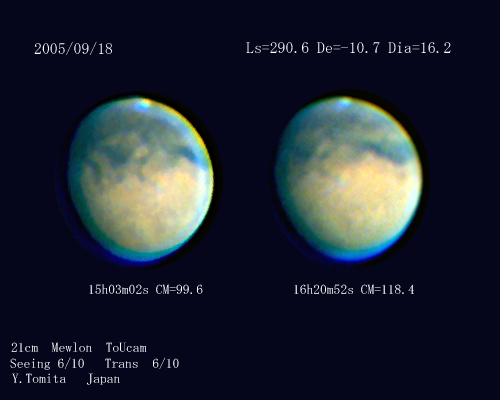 ≪群馬県佐波郡 冨田安明≫
≪群馬県佐波郡 冨田安明≫
|
Toshihiko Ikemura (310mm Newton, ATK-2C 2HS)
|
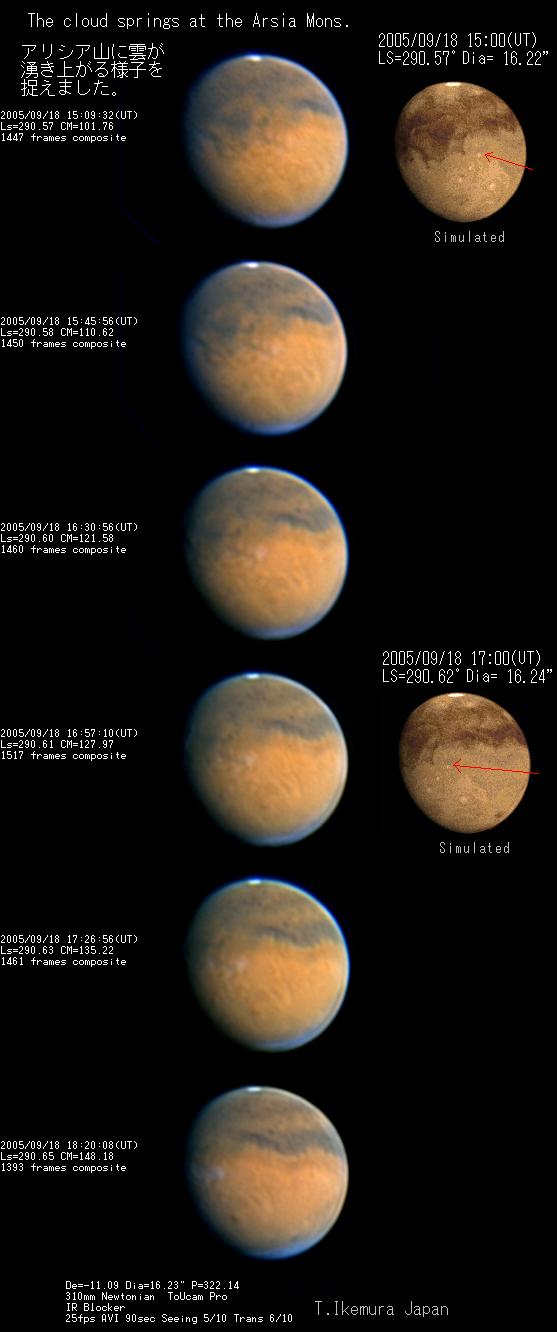
見かけはシーイングが悪く見えましたが
撮影してみると、意外に良く撮れていました。
しかし、透明度が悪く、拡大率を上げることが
出来ませんでした。
南中に近づくと急にシーイングが悪くなり
撮影を終了しました。
30ショットも撮影したので、処理にたいへん
時間がかかりました。
[T.Ikemura Nagoya Aichi JAPAN]
≪愛知県名古屋市 池村俊彦≫
|
Kenkichi.Yunoki (200mm Newtonian, ToUcam Pro)
|
撮像枚数が多かったので処理が遅れました。池村さんのアルシアモンスに立ち上る雲が私の画像にも写りました。450nm以下ののBを撮像中のモニターでもはっきりと雲がたなびいて伸びていっているように見えて異常な白い輝きが判りました。それにしても、Bでは地表の暗い模様とは別の部分が暗く写るのは興味深いです。このところしばらく、シレーンが明るく写り、その北のネムノニア付近が暗く写っています。アマゾン付近にも雲があるようも見えます。
Bだけの画像も比較しやすいように別に添付します。

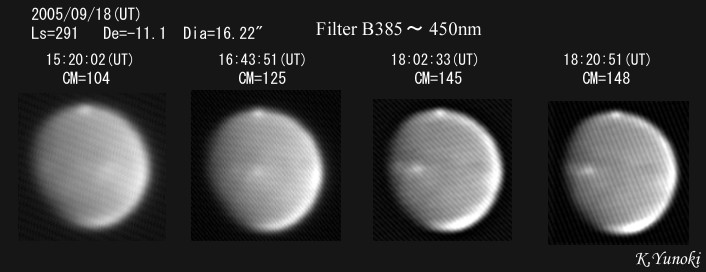
[Kenkichi Yunoki (Sakai City Japan)]
≪大阪府 堺市 柚木健吉≫
|
Hirohisa.Matsumoto (300mm Newtonian)
|
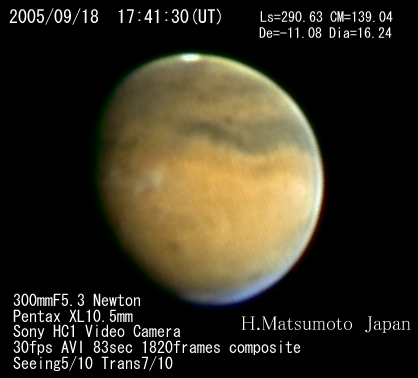
2005/09/18 17:41:30(UT)
Ls=290.63 CM=139.04
De=-11.08 Dia=16.24"
300mmF5.3 Newton (Orion鏡 自作鏡筒)
岡山県美星町せとうち天文同好会観測所にて
Pentax XL10.5mm(f/25.5)
Sony HC1 Video camera (DVモード デジタルズーム20X)
1/60sec 30fps AVI 83sec 1820frames composite
Seeing5/10 Trans7/10
-------------------------------------------------------------
コメント:
自宅の鳥取からシーイングの安定した美星町に移動し、せとうち天文
同好会の川上さんの観測所でお世話になりました。
今回ソニーのハイビジョンハンディカムHC1を初めてテスト撮影しました
が、同時に比較撮影したVX-2000と遜色ない撮影結果が得られました。
ハイビジョンモードではレジスタックスが使えないので、今回DVモード
で撮影しました。
[Hirohisa.Matsumoto (Kurayoshi City Tottori-Prefecture Japan)]
≪鳥取県 倉吉市 松本博久≫
|
Ralf Vandebergh(250mm Newton:ATK-1HS)
|
Mars image from Sept 18, session with good seeing with exellent moments.
10 inch Newton & ATK-1HS @0.08´´/p f/60 IRGB shots.
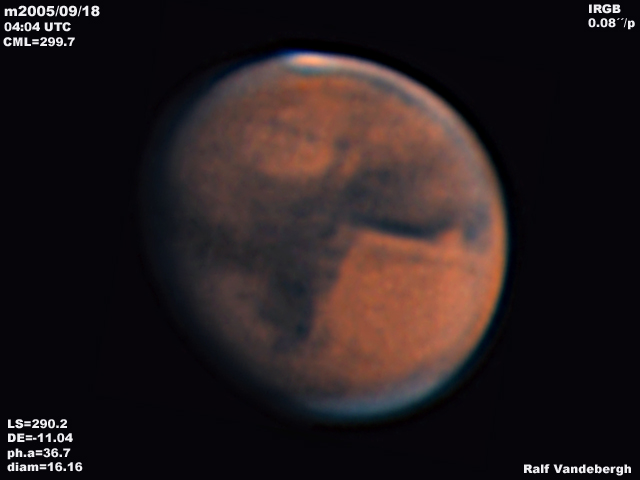 Here is another image from my Sept 18 Mars observing session,taken 3 minutes later then the previous one.
Small detail in and around Syrtis Major can be seen.
10 inch Newton & ATK-1HS camera @ 0.08´´/p res f/60 IRGB filtered images.
Here is another image from my Sept 18 Mars observing session,taken 3 minutes later then the previous one.
Small detail in and around Syrtis Major can be seen.
10 inch Newton & ATK-1HS camera @ 0.08´´/p res f/60 IRGB filtered images.
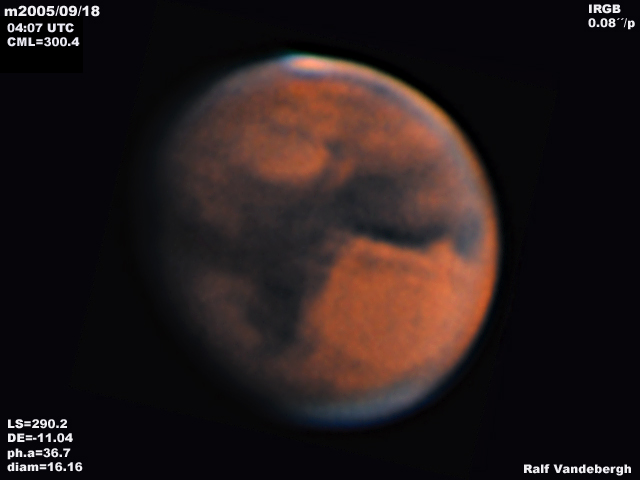 [バンディバ:オランダ]
[Ralf Vandebergh:Neighbourhood of Maastricht Netherlands]
[バンディバ:オランダ]
[Ralf Vandebergh:Neighbourhood of Maastricht Netherlands]
|
Geert Vandenbulcke(280mm SC(C-11);DMK 021BF04 Firewire Camera)
|
Images made with my Celestron 11 @ f/30 and DMK 024BF04 camera.
Seeing estimated 5 to 6/10, Transparency 8 to 9/10 with clouds coming in at
the end of the session.
Haze visible over NPC, in the first series a bright spot near Isidis Regio
(best visible on IR-Pass image).
Geert Vandenbulcke, Belgium.
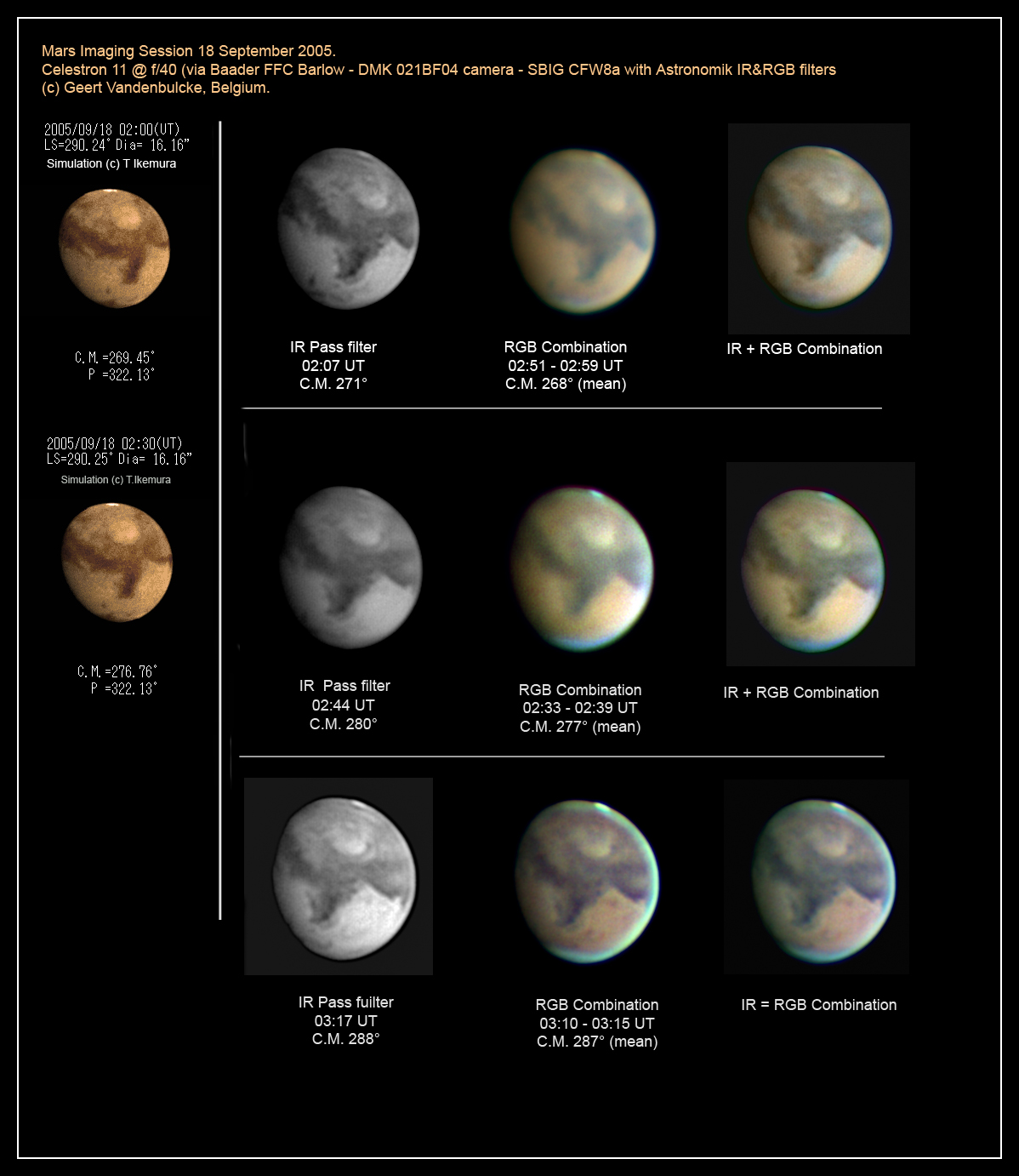 [ Geert Vandenbulcke:Koksijde, Belgium]
[ Geert Vandenbulcke:Koksijde, Belgium]
|
Ricardo Nunes(Celestron C8 QCPro4000)
|

Mars on 2005/09/18 03:15 UT
CM 288, Dia. 16.2''
QCPro 4000 + 8'' SCT @f/30
Seeing 6/10
W25 with IR cut off - 1275 frames stack
RGB images with IR cut on - 675 frame stack.
f/30 composite of 999 frames
[Ricardo Nunes : Lisbon, Portugal]
|
Jan Adelaar(178mm (7') Maksutov cass:ToUcam)
|
Did get chance to finish some avi's, and the bright spot is there easy in blue but even in IR one can see a brightening this should ad some evidence for dust and/or a cloud
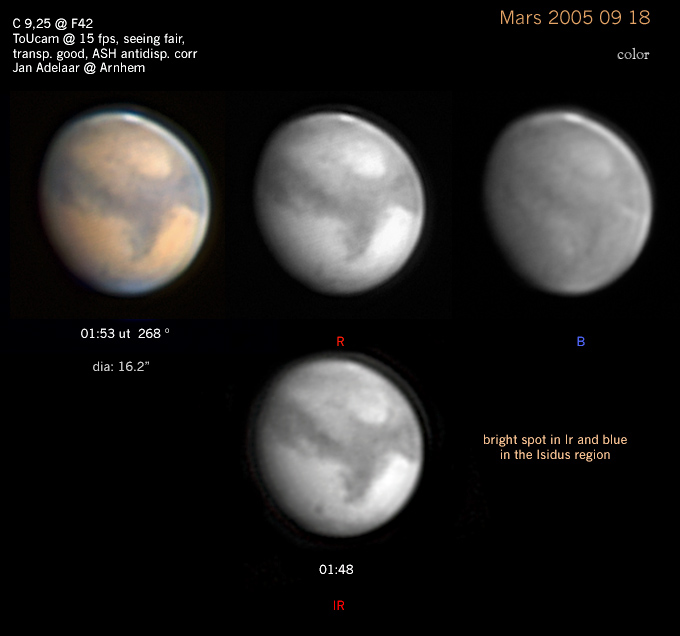
[ジャン-アデラー:オランダ]
[Jan Adelaar:Arnhem City Netherlands]
|
John Kirchhoff(235mm SCT" ToUcam)
|
Had some of the best seeing conditions in the past month with very good transparency and seeing 7/10(Pickering).
A large amount of haze is seen over the North Polar area and was very evident at the eyepiece as well as with the webcam. There also appears to be a trace of haze on the limb of the planet in the general region of Chryse.

[John Kirchhoff Hudson, Michigan, U.S.A.]
|
Damian Peach (235mm Celestron SCT:Lumenera LU075)
|
Here are some images from yesterday. Seeing was mostly good, though allot of low cloud was present at times. Much the same as the session before. The 0307 colour image is true RGB and shows some interesting colour, notably a yellowish Hellas. In Blue the haze over Hellas weakens considerably as it moves away from the morning limb. Also a large weak haze again over Libya.

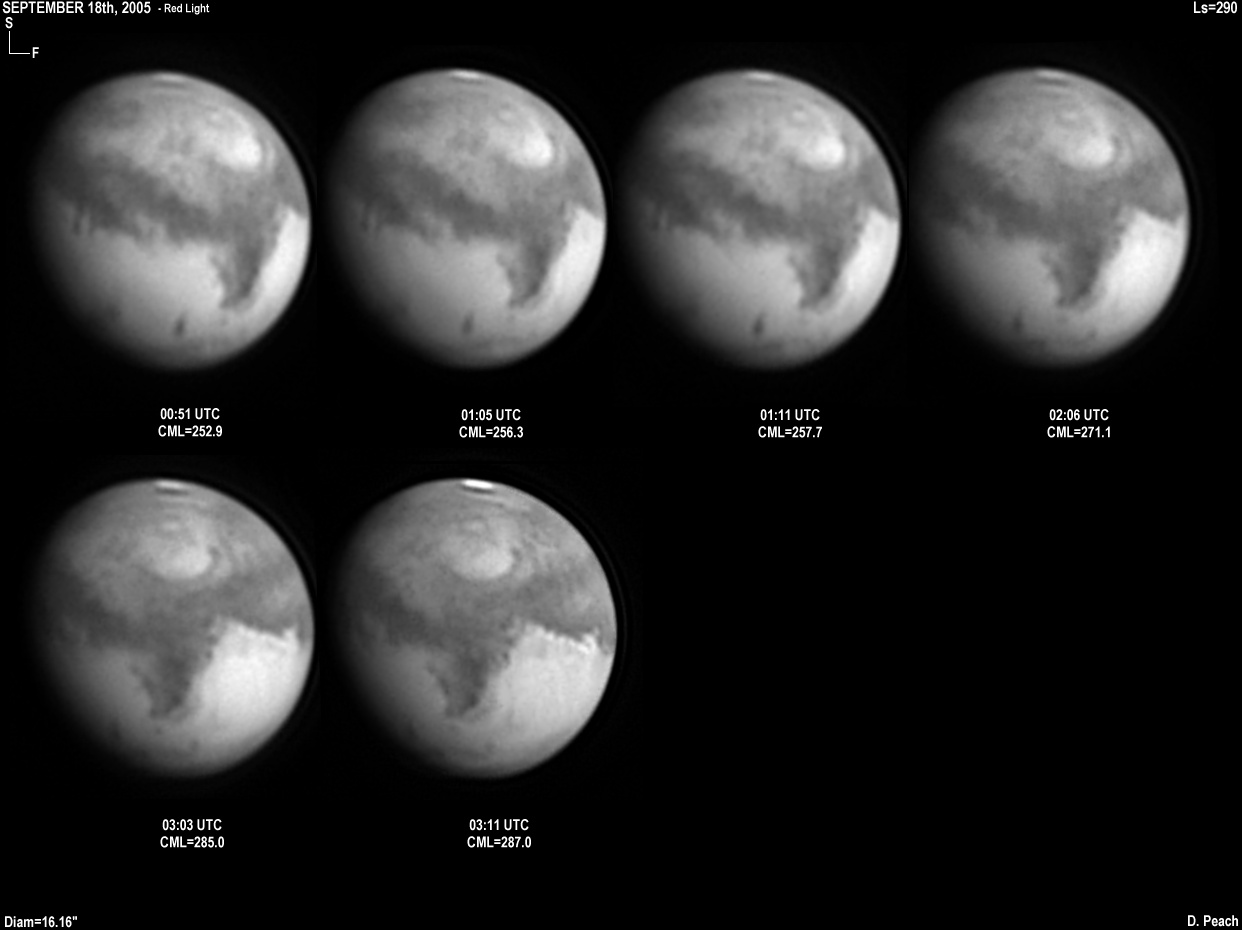
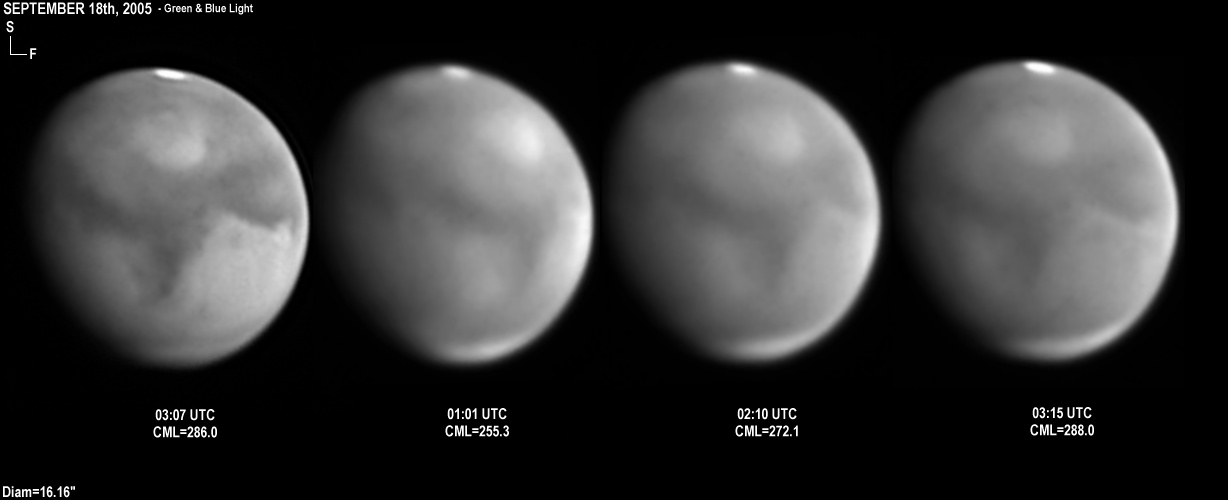
14" (35cm) Celestron SCT @ f/39.5. Lumenera LU075M CCD camera. Seeing good (Pickering 6-8.)
Transparency excellent (6.0mag.) freq low clouds. Wind NE (0-5mph.) Moderate dew. Alt= 44-54 degs.
[Damian Peach: Loudwater, Buckinghamshire, United Kingdom]
|
Richard Bosman(280mm SC:ATK-2HS)
|
Hi all, here a image from 18 sept.
I try a new processing, hope it will do.
C11 end 5x barlow and ATK-2HS IR,R,G,B filter.
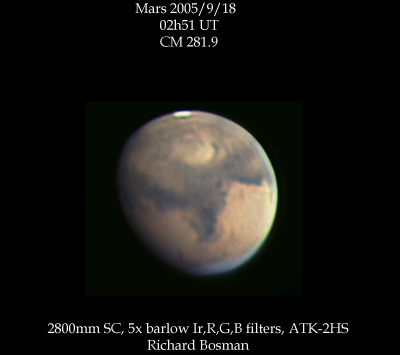 [ボスマン:オランダ]
[Richard Bosman: Netherlands]
[ボスマン:オランダ]
[Richard Bosman: Netherlands]
|
Christophe Pellier (C14 ; Lumenera ATK-1HS)
|
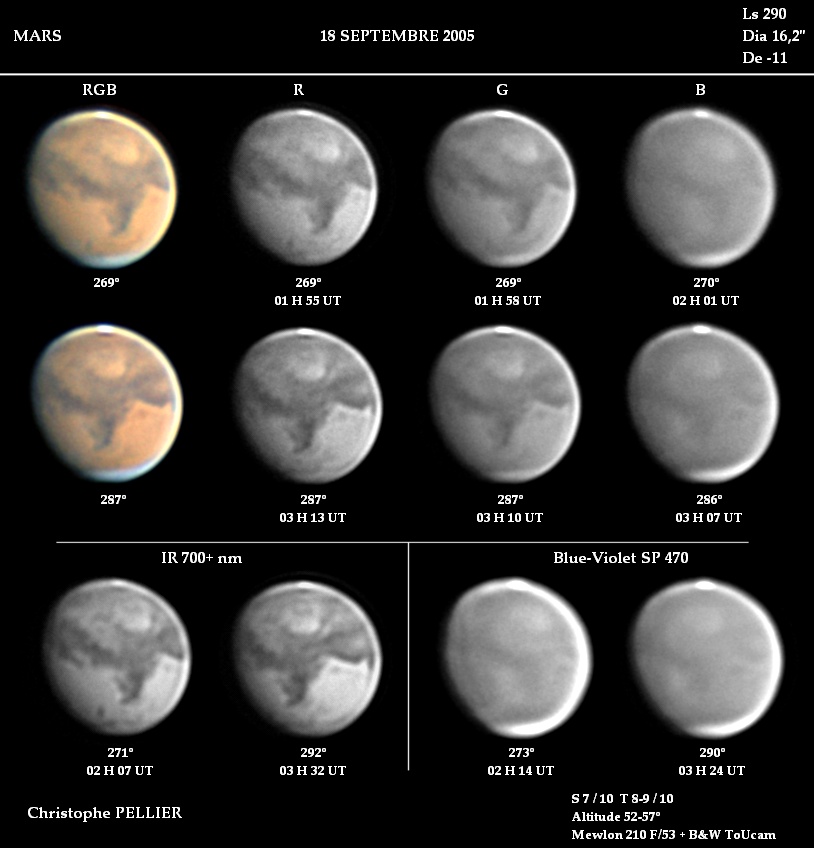
[Christophe Pellier Bruz City , France]
|
David M. Moore(25cm Newtonian, Philips ToUcam)
|
Seeing began good, but deteriorated rapidly. I omitted the last image set. The NPH is showing good development.
I see some of our good Yahoo folks have stirred the pot again! I enclose an image from last rotation on August 18,2005. It clearly shows hints of the same phenomenon in the Mare Acidalium area and is not new to many of us. Grafton and I have imaged this area's phenomena for several rotations and the past several apparitions as well. Mare Acidalium's topography or something appears to draw the Hood farther South in this region. The Hood always seems brighter here too. The area has only shown hints of this however and has not been near as visible to us till now. The striations in the Hood are most curious.
I think that as Mars draws closer, each rotation is amazing all of us and showing us more than we have ever seen before. We are getting the first good glance of the North as the Martian declination declines and therefore are getting a better insight of the Hood forming. For most of us we have never had the technology to image like this before. It is not necessarily anything new to Mars, but new to us!
As for dust, I still look for obscuration. We must be careful not to jump to conclusions as image processing can cause artifacts and highlights simple bright areas of Mars. We have already witnessed this several times this year. My two cents worth.
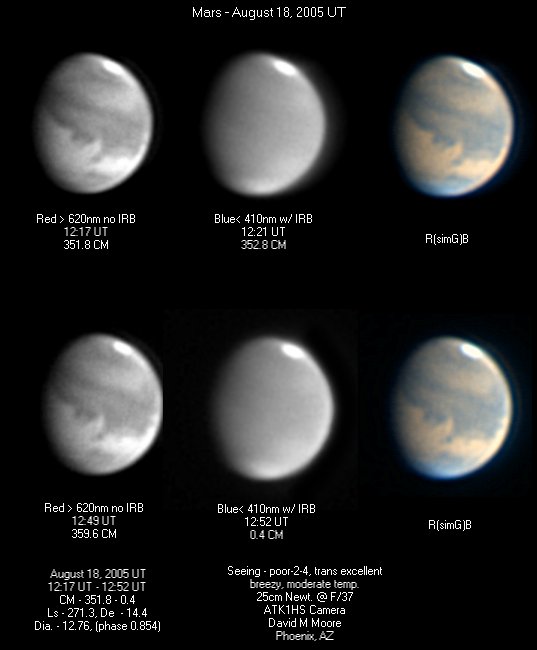
[ David M Moore Phoenix, Arizona U.S.A]


 [Takashi Suzuki (Hachiouji-City Tokyo Japan)]
≪東京都八王子市 鈴木 隆≫
[Takashi Suzuki (Hachiouji-City Tokyo Japan)]
≪東京都八王子市 鈴木 隆≫ [Ayauta-gun Kagawa-Prefecture Japan]
≪香川県 綾歌郡 瀧本郁夫≫
[Ayauta-gun Kagawa-Prefecture Japan]
≪香川県 綾歌郡 瀧本郁夫≫ ≪神奈川県 横浜市 三品利郎≫
≪神奈川県 横浜市 三品利郎≫
 [Masaru Arai Yorii-machi Saitama-Prefecture Japan]
≪埼玉県寄居町 新井 優≫
[Masaru Arai Yorii-machi Saitama-Prefecture Japan]
≪埼玉県寄居町 新井 優≫ ≪三重県熊野市 畑中明利≫
≪三重県熊野市 畑中明利≫ ≪群馬県佐波郡 冨田安明≫
≪群馬県佐波郡 冨田安明≫



 Here is another image from my Sept 18 Mars observing session,taken 3 minutes later then the previous one.
Small detail in and around Syrtis Major can be seen.
10 inch Newton & ATK-1HS camera @ 0.08´´/p res f/60 IRGB filtered images.
Here is another image from my Sept 18 Mars observing session,taken 3 minutes later then the previous one.
Small detail in and around Syrtis Major can be seen.
10 inch Newton & ATK-1HS camera @ 0.08´´/p res f/60 IRGB filtered images.
 [バンディバ:オランダ]
[Ralf Vandebergh:Neighbourhood of Maastricht Netherlands]
[バンディバ:オランダ]
[Ralf Vandebergh:Neighbourhood of Maastricht Netherlands] [ Geert Vandenbulcke:Koksijde, Belgium]
[ Geert Vandenbulcke:Koksijde, Belgium]





 [ボスマン:オランダ]
[Richard Bosman: Netherlands]
[ボスマン:オランダ]
[Richard Bosman: Netherlands]

 ALPO-Japan Latest
ALPO-Japan Latest